Research
- Prescribed Fire and Canopy Gap Disturbances in Upland Oak Forests
- Tree Traits and Upland Oak Flammability
- Effects of Prescribed Fire Season and Deer Herbivory on Upland Oak Forests
- Larch Recruitment Failure and Increased Wildfire Severity in the Siberian Arctic
- Climate Warming, Wildfire Severity, Forest Regrowth, and Carbon Cycling in the Siberian Arctic
- Habitat Fragmentation and Thornscrub Forest Restoration
- Inventory & Monitoring Protocols for the Southeast Region of the US National Wildlife Refuge System
Prescribed Fire and Canopy Gap Disturbances in Upland Oak Forests (2015 – 2018)
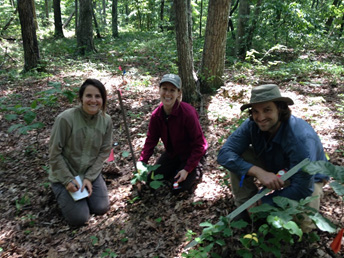
Graduate student Emily Babl (left), research associate Rachel Arney (center), and graduate student Brian Izbicki (right) measure oak and competitor seedlings at Bernheim Arboretum and Research Forest during summer 2017.
In the central hardwood and southern Appalachian regions of the eastern United States, fire suppression has led to oak (Quercus spp.) regeneration difficulties and a compositional shift towards more shade-tolerant, fire-sensitive species with the potential to modify ecosystem dynamics. Because oaks strongly influence nutrient cycling and forest hydrology and support numerous wildlife and pollinator species, oak conservation is essential and increasingly important to these regions.
Considerable evidence suggests reintroduction of fire can maintain upland oak ecosystems by removing competing species and increasing understory light. A number of studies are being conducted in collaboration with Bernheim Arboretum and Research Forest, located in Clermont, KY, with the overarching objective of better understanding oak and competing species regeneration in response to prescribed fire and canopy gap disturbances. Our working hypothesis is that multiple disturbances will promote oak regeneration and recruitment into the canopy by increasing light and minimizing competition. Our findings will determine how multiple disturbances can preserve upland oak ecosystems and determine future upland oak dynamics.
Collaborators:Brian Izbicki1, Heather D. Alexander1, Brent Frey1, Andrew I. Berry2; 1Department of Forestry, Forest and Wildlife Research Center, Mississippi State University, 2Bernheim Arboretum and Research Forest, Clermont, KY
Funding: U.S. Department of Agriculture McEntire-Stennis
Tree Traits and Upland Oak Flammability (2016 – current)
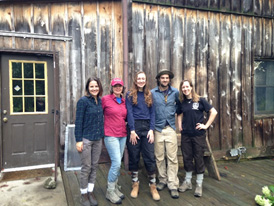
The Forest and Fire Ecology Lab (Left to right: Emily Babl, Heather Alexander, Evie Von Boeckman, Brian Izbicki, and Rachel Arney) after a hard day in the field at Bernheim Arboretum and Research Forest, KY.
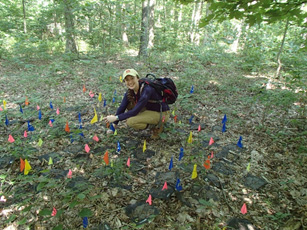
Evie Von Boeckman helps install a litter bag decomposition study at Bernheim Arboretum and Research Forest, KY.
Upland oak stands across the eastern United States are experiencing a compositional shift as oaks (shade-intolerant, fire-tolerant species) are being replaced by mesophytes (shade-tolerant, fire-sensitive species). Without fire as a disturbance in upland oak ecosystems, mesophytic species, such as red maple and sugar maple, are able to establish in upland oak territory and may create moist, cooler conditions in their understory, a hypothesized process called mesophication.
Although mesophication has become a wide-spread and seemingly well documented phenomenon, the mechanisms by which mesophytes act to suppress fire have been relatively unstudied. This fact, combined with management practices that use prescribed fire to restore upland oak ecosystems, brings us to the question: What impacts do mesophytes and oaks have on their understory conditions, and are conditions under a mesophyte canopy less flammable than under oak?
We hypothesize mesophytes will have higher leaf area, and greater crown area and volume, leading to lower light levels, cooler air temperatures, and higher fuel moisture beneath their canopies. This can dampen the effects of a surface fire. Mesophyte leaf litter will be thinner, less abundant, exhibit less curling, and have lower lignin content, leading to increased decomposition and reduced fuel mass in the litter layer, further dampening the effect of fire. Answering these questions is essential to understanding future forest flammability as mesophytes begin to occupy the midstory and eventually replace oaks in the overstory. Will fire be an effective restoration tool, and at what point are these compositional shifts too labor-intensive to reverse?
Collaborators: Emily K. Babl1, Heather D. Alexander1, Courtney M. Siegert1, John L. Willis1, and Andrew I. Berry2; 1Department of Forestry, Forest and Wildlife Research Center, Mississippi State University, 2Bernheim Arboretum and Research Forest, Clermont, KY
Funding: U.S. Department of Agriculture McEntire-Stennis
Effects of Prescribed Fire Season and Deer Herbivory on Upland Oak Forests (2017 – current)
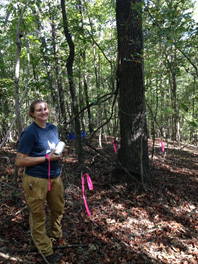
Graduate student Jennifer McDaniel installs leaf litter collection nets for a forest fuels study to begin this winter.

Graduate student Emily Babl and undergraduate researcher Evie Von Boeckman measure tree seedling size in October 2017.
Eastern oak forests are historically fire-maintained, but are currently undergoing compositional shifts due to past fire suppression, and the resulting increase in fire-sensitive, shade-intolerant hardwood competitor species creates relatively inflammable ecosystems. This increased dominance of fire-sensitive species, known as mesophytes, and resulting lowered flammability, constitute a process termed mesophication. Changes in forest composition and structure likely lead to changes in fuel loads and moisture, vegetation community, water cycling, and wildlife use.
We are broadly interested in how fire season influences upland oak forests, the role of deer herbivory, and how vegetation influences forest flammability. At Spirit Hill Farm in northern Mississippi, we are implementing spring and summer prescribed fires and installing deer exclusion fences in upland hardwood stands with no recent fire history. Specific questions include
- How does leaf litter of oak and fire-sensitive species differ in structure and flammability?
- How do oak and competitor seedlings respond to spring and summer burns and deer herbivory?
- How does prescribed fire affect oak and mesophyte water cycling?
- How do oaks and competitor species differ in sprouting ability relative to season of burn?
Collaborators: Heather Alexander1, Marcus Lashley2, Courtney Siegert1, Carolina Baruzzi2, Natasha Drotar1, Jennifer McDaniel1, Shawn Woodard1; 1Department of Forestry, Forest and Wildlife Research Center, Mississippi State University, MS, 2Department of Wildlife, Fisheries, and Aquaculture, Forest and Wildlife Research Center, Mississippi State University, MS
Funding: U.S. Department of Agriculture McEntire-Stennis
Larch Recruitment Failure and Increased Wildfire Severity in the Siberian Arctic (2017 – 2021)
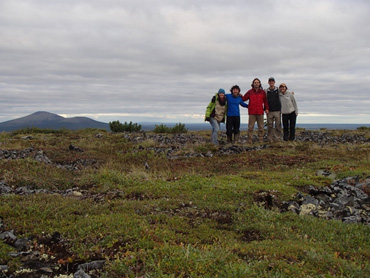
The Forest and Fire Ecology Lab (Left to right: Heather Alexander, Homero Pena, Brian Izbicki, Eric Borth (University of Dayton), and Emily Babl) traveled to Cherskii, Russia and scouted new sites for this project in summer 2017.
Larch forests overlie 70% of Siberia’s permafrost and contain half the carbon in Eurasian boreal forests. Although larch is a fire-dependent species, our previous research and that of others suggests that increased fire activity may limit larch forest recovery and potentially trigger forest loss and a shift to alternative successional trajectories dominated by shrubs or grasses. Forest loss could have large consequences for climate feedbacks via changes in C storage and albedo. Larch forests occur across much of Arctic treeline in Siberia, and future larch recruitment dynamics will be a primary determinant of whether boreal forests respond to climate warming via treeline migration or retrogression.
Despite the global importance of these forests and the potential for an altered fire regime to modify recruitment patterns and future forest cover, larch forests of Eurasia remain largely understudied compared to boreal forests of North America. The myriad mechanisms governing post-fire larch recruitment and the consequences for system-level feedbacks to regional and global climate remain untested. This research will fill these knowledge gaps by linking constraints on larch forest recruitment after fire to system-wide observations of larch recruitment failure and associated feedbacks to climate.
Collaborators: Heather D. Alexander1, Michael M. Loranty2, Jennie DeMarco3, Michelle C. Mack4, Rebecca Hewitt4, Jeremy Lichstein5, Sergey Davydov6, and Valentin Spektor7; 1Department of Forestry, Forest and Wildlife Research Center, Mississippi State University, 2Department of Geography, Colgate University, 3Colorado Western University, 4Northern Arizona University, 5University of Florida, 6Northeast Science Station, Cherskiy, Russia, 7Melkinov Permafrost Institute, Yakutsk, Russia
Funding: National Science Foundation
Climate Warming, Wildfire Severity, Forest Regrowth, and Carbon Cycling in the Siberian Arctic (2012 – 2018)
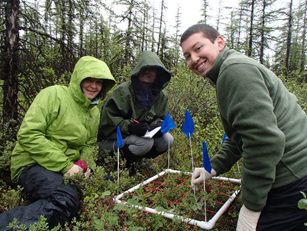
Sampling understory vegetation in the Siberian Arctic (Heather Alexander, Melissa Boyd (Northern Arizona University), and Homero Pena).
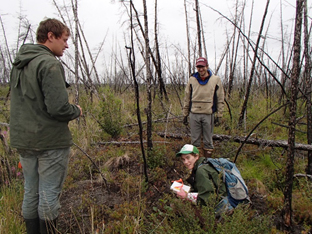
Sampling soils in a recently burned stand in the Siberian Arctic (Nikita Zimov, Ludda Ludwig (Woods Hole Research Center), and Michael Loranty).
Fire activity is increasing across the boreal forest biome in conjunction with climate warming. Boreal forests store one of the world's largest and most vulnerable terrestrial carbon (C) pools in continuously frozen soils called permafrost. The potential release of C from permafrost soils can easily double the amount of CO2 currently found in the atmosphere and further exacerbate climate warming, increasing the need to understand how changing fire regimes will affect boreal forests.
The primary objective of this study is to determine how increased fire severity affects C cycling in Cajander larch (Larix cajanderi) forests of far northeastern Siberia. Cajander larch forests are a critical part of the global carbon cycle because they 1) grow over carbon and ice-rich 'yedoma' permafrost, 2) comprise a large portion of the boreal forest biome, yet are understudied compared to Western boreal forests, and 3) are deciduous conifers and likely differ ecologically from their Western evergreen counterparts.
We hypothesize that increased fire severity would increase consumption of the soil organic layer (SOL) that overlays mineral soils, increasing larch seed germination and establishment, and leading to dense forests at maturity. These denser forests will store more C in the trees themselves, but have lower understory C pools associated with reduced light availability, soil temperature, and thaw depth; however, this decrease in understory C will not offset the C gain in the trees. Finally, reduced light input to the forest floor will better preserve permafrost soils, keeping stored C from being lost to the atmosphere.
Collaborators: Heather D. Alexander1, Susan M. Natali2, Michael M. Loranty3, Michelle C. Mack4, Homero Pena III1, Sergey Davydov5, and Nikita Zimov5; 1Department of Forestry, Forest and Wildlife Research Center, Mississippi State University, 2Woods Hole Research Center, 3Department of Geography, Colgate University, 4Northern Arizona University, 5Northeast Science Station, Cherskiy, Russia
Funding: National Science Foundation
Habitat Fragmentation and Thornscrub Forest Restoration (2012 – current)
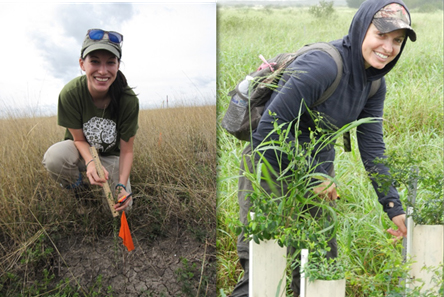
Graduate student alumni, Krysten Dick (left) and Jennifer Vela (right), measure thornscrub seedling growth and survival at Laguna Atascosa National Wildlife Refuge, TX.
Tamaulipan thornscrub forests of south Texas and northeastern Mexico represent a diverse assemblage of ~50 woody plant species that have experienced substantial loss and fragmentation since the early to mid-1900s due to land conversion to pasture, agricultural development, and urbanization. These land use changes played a major role in wildlife population losses. Approximately 145 animal species use thornscrub forest habitat, and many of these are listed by the United States Fish and Wildlife Service (USFWS) as target species that require immediate protection. Most notably, the Federally-endangered ocelot (Leopardus pardalis), with ~30 individuals remaining in the U.S., relies on the dense thornscrub forests of south Texas as their only suitable habitat. However, land conversion has reduced thornscrub forests by greater than 95%, and stressors, including competition with invasive grasses, mammalian herbivory, and drought, threaten the success of restoration efforts.
We are assessing the effectiveness of multiple restoration treatments aimed at improving survival and growth of thornscrub forest seedlings planted in old agricultural fields. Overall, we have found that grass-specific herbicide most effectively increases seedling survival and basal diameter growth, whereas shelter tubes prove most useful for promoting height growth. Thus far, planting pre-prescribed fire and high density plantings have not been effective at improving seedling survival or growth. Understanding which restoration strategies most effectively alleviate stressors and promote survival and growth of revegetated thornscrub forest seedlings is imperative for implementing successful restoration practices.
Collaborators: Heather D. Alexander1, Jonathan Moczygemba2, Krysten Dick3, Jennifer Vela4; 1Department of Forestry, Mississippi State University, 2U.S. Fish and Wildlife Service, 3Indiana Department of Natural Resources Division of Fish and Wildlife - Crosley Fish & Wildlife Area, 4Harlingen High School South
Funding: U.S. Fish and Wildlife Service
Inventory & Monitoring Protocols for the Southeast Region of the US National Wildlife Refuge System
Through a cooperative agreement between the US Fish and Wildlife Service Inventory and Monitoring Program and Mississippi State University, Rachel Arney wrote a national protocol framework for the inventory and monitoring of forested habitats in the southeastern United States. The goal was to produce standardized forest monitoring and inventory protocols across refuges to ensure robust and consistent data collection, and to support data comparability across studies and geographic areas.
Collaborators: Rachel Arney1, Janet Ertel2, Tim Fontinos2, and Heather D. Alexander1; 1Department of Forestry, Mississippi State University, 2U.S. Fish and Wildlife Service
Funding: U.S. Fish and Wildlife Service

